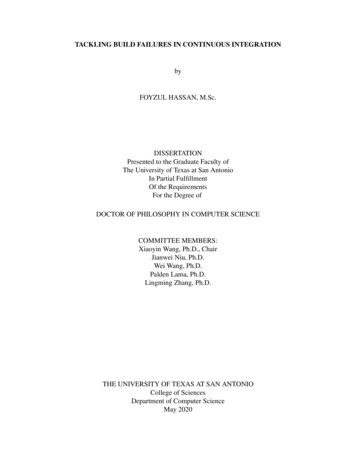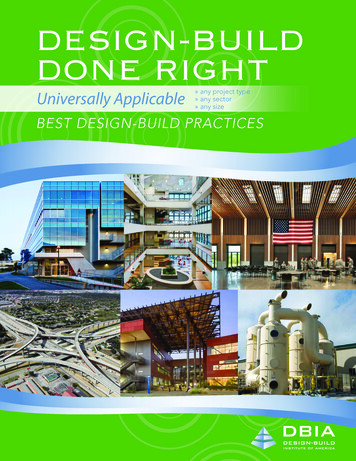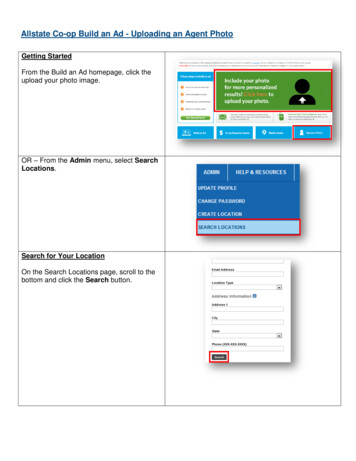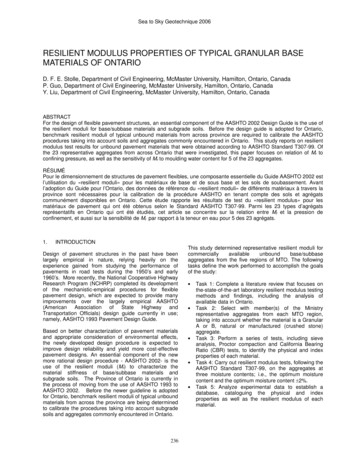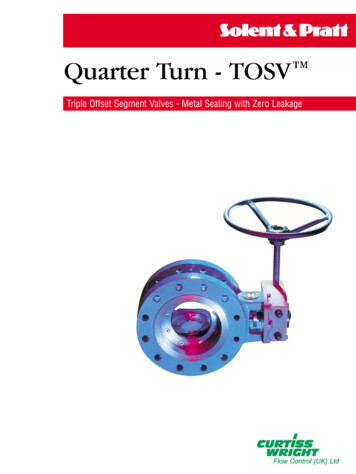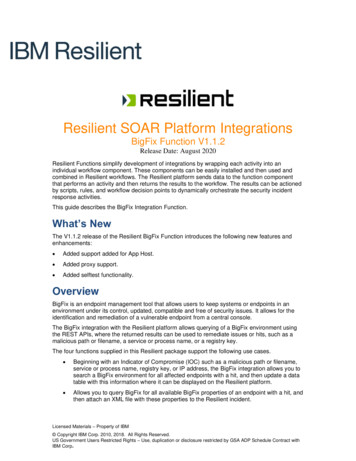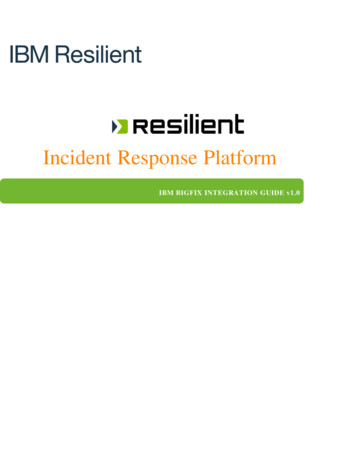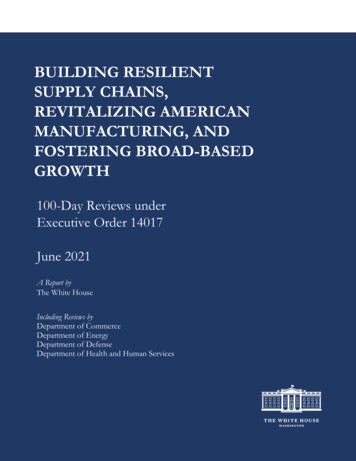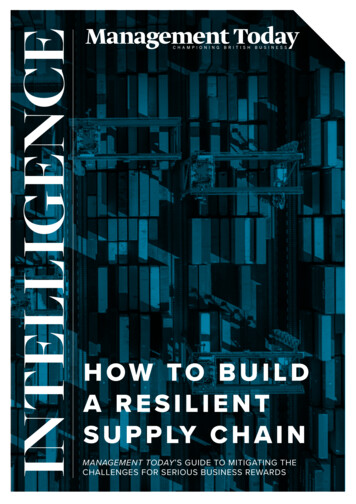
Transcription
INTELLIGENCEHOW TO BUILDA RESILIENTS U P P LY C H A I NMANAGEMENT TODAY’S GUIDE TO MITIGATING THECHALLENGES FOR SERIOUS BUSINESS REWARDS
2Words: Jeremy HazlehurstIntelligence 2021“Just get me my fucking ponchos!” So went the cry of a fashioncompany chief executive recently, as he realised that the productswhich usually arrived on time and without hitches from China wereheld up somewhere between the factory and his warehouse in the UK.And who can blame him for being irate? Over the past quarter decade,retailers and others have become used to goods flowing smoothly acrossthe world, arriving ever-quicker and at ever-lower cost. But a supplychain is a bit like household plumbing. When everything is workingwell, nobody gives it a thought. When there’s a blockage, the situationbecomes very dire very quickly, and everyone realises that they don’thave a clue how the system works. At the moment, blockages areoccurring everywhere.The world is in the midst of a supply chain crisis, which is particularlyacute in the UK. Things began breaking down when the country wentinto lockdown in early 2020, when goods like pasta and toilet paperseemed to vanish from the shelves. As people began working fromhome, demand for computer monitors, office chairs and exerciseequipment rocketed, and so did waiting times for these goods. Portsand factories ground to a halt as lockdowns came into force worldwide.60,000Number of container shipsin the worldAs the Brexit deal kicked in, some companies found that they hadto fill in onerous paperwork and it became harder for their productsto cross the English Channel. Some European firms simply stoppedsupplying the UK. A global dearth of microchips meant that cars couldnot be built, and anyone trying to buy a new vehicle is facing a wait ofindeterminate length.In late 2021, a lack of HGV drivers, sensationalist media coverage andconsumer panic led to petrol shortages and empty supermarket shelves.The problems are not going away. “Every business I know expects thisto last into 2023 and 2024,” Ian Wright, CEO of the Food and DrinkFederation, told the House of Commons recently. The result will behigher prices, inflation and, quite possibly, many companies going bust.If you are running a British business, what can you do about this? Howcan you ensure that your supply chain is resilient? To answer thoseJ
3Intelligence 2021questions, you first have to understand why the supply chain problemshave emerged. And that requires understanding the nuts and bolts ofthe global economy.How supply chains currently workThe spread of containerisation (transporting freight by placing it inlarge containers) in the 1960s and onwards, China’s embrace of a promarket, export-led economic model and the copycat growth of otherlow-wage Asian economies such as Vietnam have led to the offshoringof much manufacturing from Europe and North America. The system isbased on the concept of “just-in-time” supply chains. In order to reducethe cost of warehousing and inventory, goods are moved so they arriveat the moment they are needed.This leads to processes that are either incredible feats of humaningenuity or completely absurd, depending on your point of view.For example, the crankshaft of a BMW Mini moves back and forwardbetween the UK and Europe several times during its manufacture. It isbuilt in France before being transported to a factory in Hams Hall inWarwickshire to be finished, then sent to Munich to be inserted into anengine, before finally being shipped back across the English Channel toOxford, where the engine is fitted into the shell of the car.1.5millionNumber of people oncontainer ships at any onetime – that’s 0.02% of theworld’s populationThat all this complicated moving of goods around the planet actuallyworks might make you think that supply chains are incredibly slickthings, perhaps like the delicate innards of a Swiss watch. JessicaSpungin, adjunct professor of strategy and entrepreneurship at LondonBusiness School, says a messier metaphor is more apt: “Picture abathtub. It takes time to fill the bath and get it to the right temperature.You’ve got to have a plug that doesn’t leak, taps with the right waterpressure and pipes that aren’t blocked. I always say to my students,everyone wants their bath a particular way – you might like a glass ofwine, you might like a friend in the bath with you. It takes time to fill allthe baths to everyone’s tastes.“Now I’m going to tell you that all the baths are connected. If one getsblocked, or doesn’t fill quickly enough, or is too hot, then the wholesystem will be affected. Instead of water, the elements of the supplychain are in those baths: raw materials, finished goods, and factoryworkers moving through ports, warehouses and factories. Imagine onebath has all the drivers in it. If that is empty, then your ability to keepyour warehouses stocked is completely decimated.”JSource: Arriving Tomorrowby Christopher MimsIt is not only complex machinery that makes these strange journeys.A few years ago, it was revealed that Scottish prawns were being sentto China to be shelled before being re-imported to be sold in Britishsupermarkets as scampi, that coffee grown in Africa was packaged inIndia, and Bolivian nuts were bagged in Italy.
4Intelligence 2021Warehouses operate best with a certain level of inventory, factories aremost efficient at certain levels of demand, and ports operate optimallywith a certain number of ships entering each day. Even if more driverscould quickly be found on a particular day, that might not help becauseof the knock-on effects of previous delays. Some goods are perishable,too, and need to be moved to retailers before they spoil.A vulnerable systemIt took years, even decades, to create a system that movedgoods quickly enough around the world, at tolerablecosts. Just-in-time supply chains appealed to CEOsbecause they cut cost.76millionNumber of standard, 40-feetshipping containers thatmoved goods in 2019However, the system is vulnerable to sudden changes in supply ordemand. For example, when lockdowns struck, factories had to close,so certain products simply stopped being made. Also, lockdownschanged patterns of consumption overnight. “There was plenty of pastain the country, but it was all in the 10kg bags they use in the big pizza“THE SUPPLY CHAIN HAS BECOME ONE OFTHE KEY BATTLEGROUNDS IN BUSINESSPERFORMANCE, AND PERFORMING WELLIN THAT SPACE CAN MAKE A REALDIFFERENCE TO YOUR BUSINESS”and pasta chains, and nobody was eating out,” Spungin says. “You can’tovernight turn that bag of pasta into 20 500g bags.”Some see this inflexibility as evidence of a deep dysfunction. RyanPeterson, CEO of US freight forwarding company Flexport, which helpsto smooth the flow of goods, has been outspoken about the problemsthis model causes. He was horrified by the situation at the vast LongBeach port in California, where dozens of ships have been idling,waiting to dock and unload their cargoes.“We stripped the shock absorbers out of the economy in pursuit ofbetter short-term metrics,” he recently wrote after taking a boat tourof the port, and seeing the fleet of waiting container ships. He believesthat the pursuit of better quarterly numbers for big companies hasmade supply chains less resilient. “The global logistics companies haveno excess capacity, there are no reserves of chassis (trailers for haulingcontainers), no extra shipping containers, no extra yard space, no extrawarehouse capacity,” he says.J
52billiontonnes of goods weretransported in containersin 2019Length of the world’sbiggest container ships, theEvergreen A-class, the firstof which came into servicein mid-2021Also, there are not enough dock workers to operate the cranes thatunload the ships. When Long Beach port announced that it would startoperating 24/7, it soon ran into a problem – people have to sleep.All this might make supply chains sound like pretty Heath Robinsonaffairs. Are they really such a disaster area? In fact, says Martin Palmer,a supply chain consultant who works with Logistics UK, a trade bodythat represents the freight industry, we should appreciate how adaptablethey are. “We should perhaps celebrate a little more of the success ofour supply chains during the past couple of years. For example, thesupermarkets didn’t really miss a beat,” he says. “Even with Brexit, therewas never a day when German cars didn’t keep coming in. Humansare tremendously resourceful and supply chains have been brilliant atdemonstrating this. Warehouses changed the way they work so thatpeople could socially distance and operate safely. When Brexit disruptedthem, one of the big container shipping companies set up a new routeinto Liverpool and trains to move their goods from there.”The future of supply chainsWhether they are messes or masterpieces, the real lesson of thesehiccups is just how critical they are to businesses. “For the past 10 or20 years, the supply chain has become one of the key battlegrounds inbusiness performance, and performing well in that space can make areal difference to your business. You only have to look at the growth ofAmazon, and how its supply chain performs, to see that it can give you areal competitive advantage,” Palmer says. “Reviewing the resilience andthe risks within your own supply chain should be part of managementthinking because if you get it right, and you get it better than yourrivals, your business will outperform theirs.”J400metresIntelligence 2021
6 4trillionValue of goods movedby shipping containerseach year 2Cost to ship a TV fromChina to the USIntelligence 2021The problems of the last year-and-a-half have highlighted theimportance of supply chains to stakeholders, says Christos Tsinopoulos,professor of operations and project management at Durham BusinessSchool. “The margin at companies like Sainsbury’s and Tesco are about3% – if they get the supply chain wrong, they will be out of business,” hesays. “In future, there will be greater emphasis on supply chains becausemore shareholders are going to be nervous about resilience than theywere before.”Businesses have to balance cost and resilience in three ways, accordingto Tsinopoulos. First, procuring goods closer to home might boostflexibility and make supplies more predictable, but it usually costsmore. A second balance concerns warehousing. Keeping more goodsin warehouses means that a business is better placed to deliver whendemand increases but, again, increases cost. A third balance is abouthow companies manage supply chains. Systems that monitor the flow ofgoods, and supply chain managers who are able to manage change, areexpensive. Businesses have to decide if they are worth it.Another principle for building resilient supply chains is to accept thatthere will always be problems. As soon as one is dealt with, anotherwill arise. You might call it the whack-a-mole model of supply chainmanagement. “We always talk about the importance of identifyingwhere your bottlenecks are, and this current situation is a textbookcase of having bottlenecks across the supply chain. Any boom in theeconomy causes stresses, and that is what we are seeing,” Tsinopoulossays. “The bottleneck that has made the news is the HGV drivers, but itwas very predictable”, being the product of wages that are too low andan ageing workforce. There is a shortage of about 60,000 drivers in theUK, which has been exacerbated by Brexit and Covid. It became a bignews story, but would not have come as a surprise to competent supplychain experts.“My prediction is that even when that is managed, there will beanother,” Tsinopoulos says. “You always have a bottleneck. You try tomanage it, but you just push it somewhere else. There will be shortagesof labour, equipment – there’s always something.”When the HGV driver shortage came to a head, and when the othersupply chain issues emerged, some companies were better preparedthan others. Tsinopoulos singles out Amazon, which has reacted wellto the crisis: “They have responded in smart ways, which have allowedthem to control the bottlenecks – for instance, using smart warehousingor smart technologies to predict consumer demand so that they knowwhere to allocate resources, and flexible contracts.”He adds: “Resilient supply chains are ones that are flexible, but alsoprepared. Nobody was prepared for such a crisis as Covid, but the onesthat were prepared for a crisis in general were better able to respond.”J
7Intelligence 2021What business leaders can doWhat can companies do to improve their resilience and flexibility?“Start by trying to see what bottlenecks you have, try to map the supplychain. My advice is not necessarily to try to remove bottlenecks, butmanage them. Imagine you are a small business which still employsHGV drivers. It might be a question of getting a more efficient roster forthem, not necessarily employing more of them,” Tsinopoulos says. Headds that the Nissan factory in the north east of England tries as muchas possible to use local suppliers. “When you drive up there, you gothrough something like a village of suppliers,” he says. “That’s not justto boost the local economy – though it does that too – it is because youcan up production quickly. It is more flexible.”Smaller businesses might not have the clout of Nissan to do that but, intheir own way, finding producers closer to home could have a similar“ IF YOU’RE GOING TO GET A CLEARER PICTURE OFWHAT IS AND ISN’T WORKING IN YOUR NETWORKOF SUPPLIERS, START HAVING THE RIGHTCONVERSATIONS NOW, BECAUSE THIS IS AS MUCHOF A CULTURAL CHANGE AS A TECHNOLOGICAL ONE”effect. Palmer says that managing your supply chain is all about havingas much information as possible. “Supply chains have always been abouttwo things, the movement of goods and movement of information,”he says. “And it has never been as important as it is now to have themovement of information piece in place. You can’t manage anything ifyou don’t have information.”For example, do you really know where your supplies are coming from?There was a famous case, Palmer says, when Ford believed they had twosuppliers of black paint. It was only when one failed to deliver that theyrealised that, in fact, the second supplier was getting it from the first.Ensuring you have multiple suppliers of a product is always smart, andit might be worth paying more for the security of having one closer tohome. “It might be cheaper to get something from China, but sensibleto have a second supplier in Turkey even if transporting the product byland costs more,” Palmer says.Having information is also not just about your own systems. A longsupply chain will involve many parties. (For example, Walmart, theworld’s largest grocery retailer, has 2,800 key suppliers in its network.)Do the participants talk to each other? In many cases, the factory,the short-haul lorry company in China, the shipping line, the freightJ
8Intelligence 2021SIX WAYS TO MAKE YOUR SUPPLYCHAINS MORE RESILIENT1. Get better data. If you don’t understand where yourblockages are, you can’t find solutions. Encourage everyonein your supply chain to talk to each other and spot problemsearly. Some participants will be more open than others butyou can at least start having the right conversations and buildon them.2. Ensure you have multiple suppliers, especially for vital goods.More expensive suppliers might hit margins, but if the cheapone fails then you have a fallback option.“AUTOMATE IFPOSSIBLE. IF YOUCAN USE ROBOTS,THE PROCESSWILL BE MOREEFFICIENT ANDHELP YOU SCALEPRODUCTIONFASTER”3. Source locally. Again, the cost might be higher but it is easierto build a partnership with a nearby supplier who can flexoutput when you need it. Build mutually beneficialpartnerships, not transactional relationships.4. Automate if possible. If you can use robots – or encourageyour suppliers to – the process will be more efficient and helpyou scale production faster. Automating the management ofyour supply chain can be expensive – and difficult – but it iskey to really enhancing resilience.5. Pay money for good advice. Supply chain experts areexpensive, but they can see bottlenecks coming down thetrack and plan for them before they happen.6. Build partnerships. Suppliers are not just cogs in a machine,their success is also tied in with yours. Talk to them and workout ways you can help achieve your goals together.forwarder, the port authority and the British lorry firm are not joinedup. This means that, when things go wrong, you might not be able tofind out where your goods really are.Transparency is coming slowly to supply chains. In the past, somesuppliers kept their sources of supply secret because they felt they werepreserving their competitive advantage. Globalisation made supplynetworks more intricate, more complex and more opaque, and manycompanies are now pushing for greater openness. If you’re going to get aclearer picture of what is and isn’t working in your network of suppliers,start having the right conversations now, because this is as much of acultural change as a technological one.J
9Intelligence 2021Automation could help your supply chain run more smoothly. When wethink of automation, we tend to imagine factories staffed by robots andthey will make fewer mistakes than a human (which can mean fewerfaults, recalls and replacements down the line) and make it easier toscale output when things change. But one automated link in a networkof hundreds of suppliers is not going to transform performance.Automating the way you manage your supply chain might be expensiveinitially but having more timely, accurate data will help you be moreresilient and more flexible. In the long run, businesses may be forcedto embrace AI anyway – the world’s largest companies are increasinglyusing it to manage their supply chains and you won’t be able to supplythem if you can’t integrate with their systems.Perhaps the tendency to see supply chains in a transactional way mightneed an upgrade, too. “As a procurement leader, I like to partner andtry to create value together,” says one chief procurement officer whodeclined to be named. “In terms of supply chain resilience, the futureis going to be more about transparency and partnerships rather thana focus on cost, cost, cost.” She thinks it is easier to have transparentsupply chains, to manage risk and to understand supply and demand ifyou talk to your suppliers. “It’s not an either/or, cost or resilience, it’s an‘and’. If you determine the motivators on both sides of the relationship,you can both get what you need.”A lot of businesses want to grow the top line, not just the bottom line– they don’t just want to take more margin, they want to grow theirmarket share. If I make chips and you make potatoes, then when I growmy market that is also good for you. “If we both want to grow, it can begood for both partners,” the CPO says.The truth is, even in this globalised world, supply chains are a littlebit ramshackle. The miracle of ordering something from a websiteon your phone and getting delivery the next day sometimes tricks usinto believing that the entire system is just as seamless as those swipesand clicks. It isn’t. Goods are moved around ports on rusty old barges,paperwork is rubber-stamped on rainy docksides by bored men ingrubby overalls and boxes are stored in dank warehouses. Once youunderstand that, you see that supply chains are not perfect. The flip sideto this, of course, is that they are always improvable. Those ponchos willeventually arrive. But there is almost certainly a way to get them morequickly next time.“THE WORLD’S LARGEST COMPANIES ARE INCREASINGLYUSING AI TO MANAGE THEIR SUPPLY CHAINS AND YOUWON’T BE ABLE TO SUPPLY THEM IF YOU CAN’TINTEGRATE WITH THEIR SYSTEMS”
INTELLIGENCENo part of this publication may be reproducedwithout the permission of the publishers. Haymarket Business Media.Management Today is a registered trademark.Published by Haymarket Business Media, BridgeHouse, 69 London Road, Twickenham TW1 3SP.Editor Kate Magee Group art director Tim ScottGroup production director Michael Porter Seniorreporter Orianna Rosa Royle Editor-in-chief RobertJeffery Director of commercial partnershipsDanielle Chapman Group director Sandie Pears
so certain products simply stopped being made. Also, lockdowns changed patterns of consumption overnight. "There was plenty of pasta in the country, but it was all in the 10kg bags they use in the big pizza THE SUPPLY CHAIN HAS BECOME ONE OF THE KEY BATTLEGROUNDS IN BUSINESS PERFORMANCE, AND PERFORMING WELL IN THAT SPACE CAN MAKE A REAL


